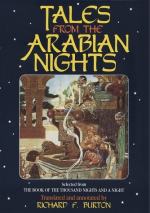[FN#305] In the Arab. “Salkh,” meaning also a peculiar form of circumcision, for which see Pilgrimage iii. 80-81. The Jew’s condition was of course a trick, presenting an impossibility and intended as a mere pretext for murdering an enemy to his faith. Throughout the Eastern world this idea prevails, and both Sir Moses Montefiore and M. Cremieux were utterly at fault and certainly knew it when they declared that Europe was teaching it to Asia. Every Israelite community is bound in self-defence, when the murder of a Christian child or adult is charged upon any of its members, to court the most searching enquiry and to abate the scandal with all its might.
[FN#306] The text has “F¡ K¡b,” which Scott (vol. vi. 367) renders “a mat.” [According to the Muh¡t “K¡b” is a small thick mat used to produce shade, pl. “Kiy b” and “Aky b.” The same authority says the word is of Persian origin, but this seems an error, unless it be related to “Keb” with the Y majh£l, which in the Appendix to the Burh ni K ti’ is given as synonymous with “Pech,” twist, fold. Under “Bard¡"==papyrus the Muh¡t mentions that this is the material from which the mats known by the name of “Aky b” are made.—St.]
[FN#307] The text has here “Wasayah,” probably a clerical error for “wa Miah” (spelt M yah"), and a hundred pair of pigeons.— St.]
[FN#308] Showing utter ignorance of the Jewish rite which must always be performed by the Mohel, an official of the Synagogue duly appointed by the Sheliach==legatus; and within eight days after birth. The rite consists of three operations. Milah==the cut; Priah==tearing the foreskin and Mess¡zah==applying styptics to the wound. The latter process has become a matter of controversy and the Israelite community of Paris, headed by the Chief Rabbi, M. Zadoc Kahin, has lately assembled to discuss the question. For the difference between Jewish and Moslem circumcision see vol. v. 209.
[FN#309] The Jewish quarter (H rah), which the Israelites themselves call “Hazer,"==a court-yard, an enclosure. In Mayer’s valuable “Conversations-lexicon” the Italian word is derived from the Talmudic “Ghet"==divorce, separation (as parting the Hebrews from the rest of the population) and the Rev. S. R. Melli, Chief Rabbi of Trieste, has kindly informed me that the word is Chaldaic.
[FN#310] [Ar. “Sarm£jah,” from Persian “Sar-m£zah,” a kind of hose or gaiter worn over a boot.—St.]
[FN#311] [Arab. “Yastan¡t,” aor. to the preter. “istanat,” which has been explained, supra, p. 24.—St.]
[FN#312] The bed would be made of a carpet or thin mattress strewn upon the stucco flooring of the terrace-roof. But the ignorant scribe overlooks the fact that by Mosaic law every Jewish house must have a parapet for the “Sakf” (flat roof), a precaution neglected by Al-Islam.
[FN#313] Good old classical English. In the “Breeches Bible” (A.D. 1586) we read, “But a certaine woman cast a piece of millstone upon Abimelech’s head and broke his brain-panne” Judges ix. 33).




